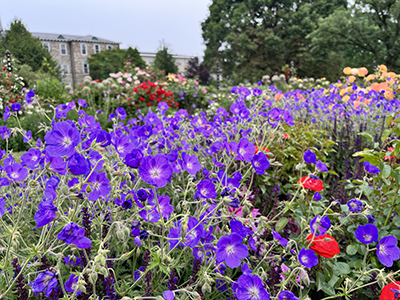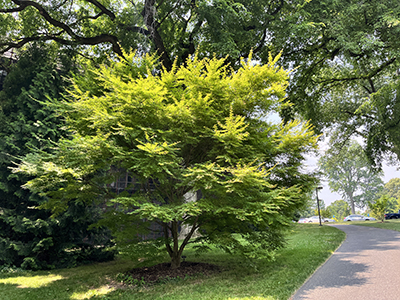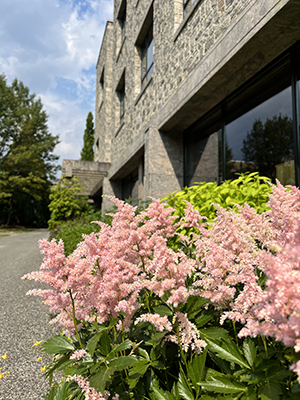
Plants of the Week: June 12
Guest Author: Devin Dawson, 2023 Summer Intern

Geranium ‘Johnson’s Blue’ (cranesbill)
The beauty of a garden comes from its cohesiveness and artful design. Our revered Dean Bond Rose Garden features a variety of breathtaking cultivars of roses, but its companion flowers deserve the same love too. As the brilliant rose garden thrives during this time of year, the Meadow Crane’s-Bill stands out as a complimentary bloom intertwined in the lush beds of roses.
The vibrant blankets of purple placed in various spots in the Dean Bond Rose Garden are composed of Geranium of the cultivar ‘Johnson’s Blue’, or commonly known as cranesbill. Bees, butterflies, and other beneficial insects love this herbaceous perennial because of its nectar-rich flowers. The 5-petal circular shaped flower thrives in full sun to partial shade and forms in clumps, usually around 3 ft wide. Geranium is native to eastern North America and hardy in Zones 3 to 8. This species is easy for gardeners to grow as a border plant due to its tolerance of heat and a wide range of soil types, except for boggy ones. Another advantage of Geranium that makes it durable is its resistance to deer and rabbits. Photo credit: D. Dawson

Acer palmatum (Palmatum Group) ‘Ueno-yama’ (Japanese maple)
With the lack of rainy days recently, the sun has been shining down and nourishing our greenery on campus virtually everyday. When strolling through on a sunny afternoon, a stand-out tree whose green foliage lets light pass through it so beautifully is the Japanese maple. Our Acer palmatum that lives between the Wister Center and the McCabe Library belongs to the cultivar ‘Ueno-yama.’ The cultivar name refers to a well known park in Tokyo called Ueno, so “Ueno Mountain” serves as a widely loved public parkland where Japanese culture is commonly celebrated.
‘Ueno-yama’ is a bushy deciduous tree that possesses a broad canopy, being almost as wide as it is tall. In addition to having rich, semi-transparent green foliage in the spring and summer, its divided palmate shaped leaves turn yellowy-orange in autumn before shedding by wintertime. It thrives in well-drained soils with even moisture and partial sun. Photo credit: D. Dawson

Astilbe x arendsii ‘Zuster (Sister) Theresa’ (astilbe)
What’s wonderful about early summer at the Arboretum is its impressive vibrant blooms. When browsing campus in search of my picks for Plant of the Week, the soft-pink, feathery sheet of astilbe was the one to literally take my breath away.
The eye-catching Astilbe x arendsii is a hybrid perennial that flowers from late spring to fall. It’s native to eastern Asia and, as a hybrid, it was developed by George Arends in the 1920s. This astilbe belongs to the cultivar ‘Sister Theresa,’ displaying soft, cherry-blossom-pink plumes and olive green glossy leaves. At maturity, these hybrids erect to be 16 inches tall and 24 inches tall including their flowers. They live and thrive in shady areas with moist, rich, and well-drained soil. Astilbe’s finely textured plumes with dainty flowers are great for cutting for arrangements. Photo credit: D. Dawson





No Comments